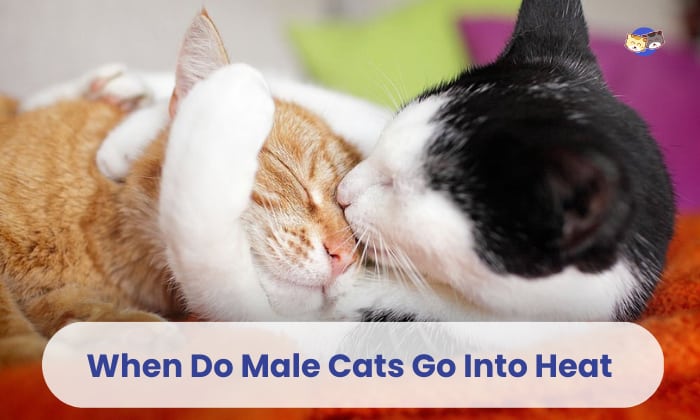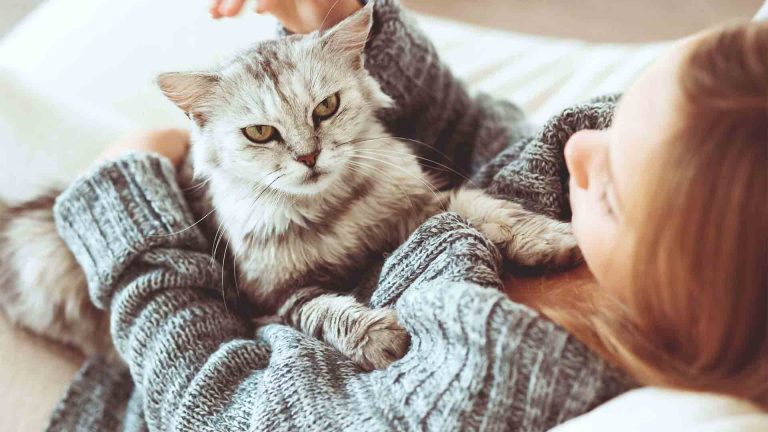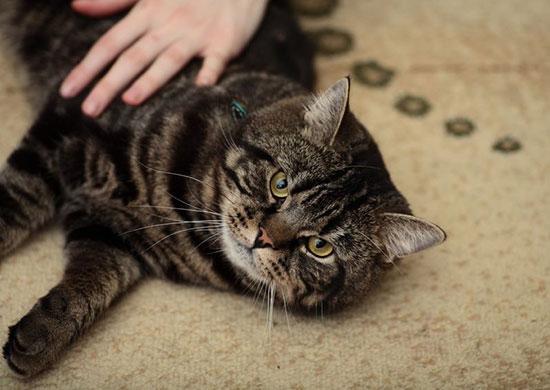Do Cats Get More Affectionate With Age?

Cats do become more affectionate as they age. As they mature, they tend to seek more warmth and closeness from their owners.
As cats grow older, they often display an increased desire for companionship and affection. While kittens are usually independent and playful, adult and senior cats become more attached to their owners and seek out physical contact and attention. This change in behavior can be attributed to a variety of factors, such as a decrease in energy levels or the need for security and comfort.
Older cats often enjoy being petted, cuddling, and being in close proximity to their owners. Understanding and fulfilling their need for affection can strengthen the bond between feline and human companions.

Credit: catfaqts.com
Factors Influencing Cat Affection
As cats age, they may become more affectionate due to several factors such as a deepened bond with their owners, a decreased need for independence, and a calmer demeanor. This increase in affection can be a heartwarming aspect of the aging process for both cats and their human companions.
Introduction
When it comes to cats, their affectionate nature is something many pet owners cherish. While it is commonly believed that cats become more aloof as they grow older, the truth is that there are several factors influencing a cat’s level of affection. Understanding these factors can help cat owners establish a stronger bond and provide the right environment for their feline companions. In this article, we will explore three key factors that influence cat affection: life stages and behavior changes, genetic predisposition towards affection, and environment and socialization.
Life Stages And Behavior Changes
Cats, much like humans, go through different life stages that can impact their behavior and level of affection. As kittens, they are often full of energy and curiosity, seeking constant attention and play. During this stage, they might display more affection as they crave interaction and socialization.
As they transition into adulthood, typically between one to five years old, cats tend to become more independent and may exhibit less overt signs of affection. This shift in behavior is influenced by their instinctual need for hunting and territorial behaviors.
In their senior years, cats may experience changes in health and mobility, which can affect their level of affection. Some older cats may become more affectionate, seeking comfort and companionship, while others may become more withdrawn due to pain or discomfort.
Genetic Predisposition Towards Affection
Genetics also play a role in a cat’s affectionate nature. Certain breeds are known for being more affectionate than others due to their genetic predisposition. For example, the Ragdoll and Maine Coon breeds are often described as being particularly loving and cuddly.
While genetics can give a general indication of a cat’s behavior, it is important to remember that each cat is an individual with their unique personality and preferences. Even within a specific breed, there can be variations in affectionate behavior.
Environment And Socialization
The environment in which a cat is raised and the socialization they receive also heavily influence their level of affection. Cats that have been exposed to positive and nurturing environments are more likely to display affectionate behavior.
Early socialization is crucial in shaping a cat’s behavior. Kittens that have been exposed to various people, animals, and stimuli from an early age tend to be more comfortable and affectionate towards others. On the other hand, cats that have had limited socialization might be more hesitant and less open to affection.
Additionally, a calm and stress-free environment can contribute to a cat’s overall well-being and affectionate behavior. A comfortable living space with plenty of hiding spots, scratching posts, and interactive toys can help cats feel secure and content, encouraging them to be more affectionate.
Understanding the factors that influence a cat’s level of affection is key to establishing a strong bond with our feline friends. By considering their life stages, genetic predispositions, and providing a nurturing environment, we can create an environment that encourages their natural affectionate behavior.
Understanding Cat Behavior
Cats may become more affectionate as they age, seeking more attention and comfort from their owners. As they mature, cats often develop a deeper bond with their humans, displaying increased warmth and attachment. Trust and love may grow over time, resulting in a more affectionate feline companion.
Cognitive Development In Cats
Cats, like humans, go through various stages of cognitive development as they age. Understanding these stages can help us better comprehend why cats may become more affectionate over time. When kittens are born, their brains are still developing, and their cognitive abilities are limited. As they grow older, their cognitive functions begin to mature, enabling them to form stronger emotional bonds with their human companions.
During the first few weeks of a kitten’s life, their brain is primarily focused on basic survival instincts and learning from their mother. As they approach four to eight weeks, they start exploring their surroundings and learning basic motor skills. This stage is crucial for their cognitive development, as they begin to recognize and understand various stimuli.
Feline Communication Signals
Cats communicate through a combination of vocalizations, body language, and scent signals. Understanding these forms of communication can help us interpret their behaviors and needs. As cats age, they become more adept at expressing their emotions and desires, including their need for affection. They may use specific signals to initiate interactions with their human companions and seek physical contact.
Some common communication signals that indicate a cat’s desire for affection include purring, rubbing their head or body against you, gentle kneading, and slow blinking. These behaviors often indicate a sense of trust and comfort with their human companion. Recognizing and responding to these signals can foster a deeper bond and increase the affection between a cat and their owner.
Impact Of Hormones On Affection Levels
Hormones play a significant role in a cat’s behavior, including their levels of affection. As cats mature and reach sexual maturity, their hormone levels fluctuate, which can affect their behavior and affection levels. For instance, intact male cats often exhibit more independent and territorial behavior, while intact female cats may become more reserved and selective in their displays of affection.
However, when cats are spayed or neutered, their hormone levels become more balanced, leading to potential changes in their behavior. Neutered males typically become more affectionate and less aggressive, while spayed females may become more sociable and seek out more physical contact. This hormonal balance can contribute to an overall increase in the affectionate behavior displayed by cats as they age.
Understanding the cognitive development, feline communication signals, and the impact of hormones on affection levels can help cat owners comprehend why their feline companions may become more affectionate over time. By recognizing and responding to these behavioral cues, cat owners can establish and nurture a deeper bond with their furry friends. So, if you’ve noticed your cat becoming more loving and cuddly as they age, it’s likely a combination of these factors at play.
Age-related Changes In Cat Affection
As our feline companions grow older, it’s natural for us to wonder if they become more affectionate with age. Cats, just like humans, experience various changes in their behavior and personality as they mature. In this blog post, we will explore the age-related changes in cat affection and delve into how kittens, adult cats, and senior cats exhibit their affectionate behaviors.
Affectionate Behaviors In Kittens
Kittens, oh so adorable and full of youthful energy, may not always display the same level of affection as they do when they are small bundles of fur. While they certainly enjoy playtime and snuggles during their early months, their need for independence gradually takes root.
Nonetheless, baby cats can still show their love and affection through some unmistakable behaviors:
- Purring: Curled up in your lap, a content kitten often purrs to express their happiness and affection. The gentle vibrations of their purring can be incredibly soothing.
- Kneading: This kneading behavior, where kittens push their paws in and out against a soft surface, is an instinctual display of comfort and bonding. They often knead their mothers while nursing and continue the behavior as a sign of affection towards their human companions.
- Head Bumps: Known as “bunting,” kittens and cats will gently nudge their heads against you as a way of marking you with their scent and showing their affection.
Shifts In Affection As Cats Mature
As kittens grow into adult cats, their needs and behaviors change. While they may become more independent and less interested in playtime, adult cats can still be quite affectionate in their unique ways.
Here are some affectionate behaviors commonly observed in adult cats:
- Grooming: Cats spend a significant amount of time grooming themselves, but they also use this behavior as a means of showing affection to their fellow felines or human companions. If your cat tries to groom your hair or nibble your fingers gently, consider it a loving gesture.
- Rubbing: Adult cats often rub their bodies against furniture, walls, or even your legs. This behavior, known as “bunting,” is a way for cats to mark their territory while also demonstrating their affection towards you.
- Cuddling: While cats may not be the most cuddly creatures all the time, many adult cats enjoy curling up next to their human companions for some quality bonding time. It’s their way of showing trust and affection.
Senior Cats And Changes In Affection
As cats enter their golden years, we may notice some additional changes in their affectionate behaviors. While senior cats may not be as sprightly as their younger counterparts, they can still shower us with love in their own gentle ways.
Some affectionate behaviors to look out for in senior cats include:
- Sleeping together: Senior cats often seek out warmth and comfort, so don’t be surprised if your elderly feline cuddles up next to you more frequently. Sharing a warm bed can be a bonding experience that showcases their enduring affection.
- Purring: Just like when they were young, many senior cats continue to purr when content or seeking comfort. If your cat purrs while they snuggle with you, it’s a sign that they value your companionship.
- Slow blinks: Known as “cat kisses,” slow blinks are a heartwarming gesture that senior cats often use to communicate their affection and trust. When your cat calmly closes and reopens their eyes while gazing at you, it’s their way of saying “I love you.”
Remember, every cat is unique, and while age can influence their behavior, individual personalities and past experiences also play a significant role. By understanding the age-related changes in cat affection, we can better appreciate and reciprocate their love throughout their lives.
Ways To Encourage Affection In Cats
When it comes to cats, it’s no secret that they can be quite aloof and independent creatures. However, as they age, many cats become more affectionate and cuddly towards their human companions. If you’re a cat owner looking to foster a closer bond with your feline friend, there are several ways you can encourage affection in cats.
Building Trust And Bonding
One of the first steps to fostering affection in cats is to build trust and establish a strong bond. Cats are naturally cautious animals, so it’s important to create a safe and secure environment for them. Provide them with their own space where they feel comfortable, such as a cozy bed or a cat tree.
Additionally, spend quality time with your cat each day. Engage in interactive play sessions using toys that simulate prey-like behaviors. This not only provides mental and physical stimulation but also helps to strengthen the bond between you and your furry friend.
Providing Enrichment Activities
Cats are curious creatures and need mental and physical stimulation to thrive. By providing enrichment activities, you can keep your cat engaged and content, which in turn can increase their affection towards you. Consider setting up a scratching post or providing puzzle toys that challenge their hunting instincts.
Furthermore, create a stimulating environment for your cat by introducing new toys, rotating them regularly to prevent boredom. You can also offer them window perches or bird feeders to satisfy their natural desire to observe the world outside. A happy and stimulated cat is more likely to seek out affection and human interaction.
Positive Reinforcement Techniques
In addition to creating a stimulating environment, positive reinforcement techniques can go a long way in encouraging affection in cats. Reward your cat’s desirable behaviors, such as using a scratching post instead of furniture, with treats or praise. This will reinforce their good behaviors and establish a positive association with you.
It’s important to note that cats respond best to positive reinforcement, so avoid punishment-based training methods. When your cat approaches you or displays affectionate behavior, be sure to offer them gentle strokes and verbal praise. Over time, they will learn to associate your presence with positive experiences, strengthening their bond with you.
Dealing With Cats That Are Not Affectionate
While many cats become more affectionate as they age, some cats may not show the same level of affection as others. It can be disheartening for cat owners who are expecting cuddles and purrs, but there are ways to address this issue and encourage a more loving relationship. Identifying the possible reasons for your cat’s lack of affection, addressing any underlying behavioral issues, and seeking professional guidance can all help create a more enjoyable and loving bond with your feline friend.
Identifying Possible Reasons For Lack Of Affection
If your cat is not displaying affection, it’s important to identify the possible reasons behind this behavior. Cats are individuals with unique personalities, and their preferences may differ from one another. However, here are some common reasons why a cat may not be as affectionate:
- Lack of socialization during their early life, which can make cats wary of human contact.
- Past traumatic experiences that have caused fear or anxiety towards human interaction.
- Misinterpretation of cat body language or cues, leading to unintentional actions that may deter the cat from seeking affection.
- Medical conditions or physical discomfort that make your cat less inclined to engage in physical contact.
Addressing Behavioral Issues
If you suspect that behavioral issues may be contributing to your cat’s lack of affection, there are several steps you can take to address these concerns:
- Creating a safe and comfortable environment for your cat, including providing hiding spots and vertical spaces for them to feel secure.
- Respecting your cat’s boundaries and personal space, allowing them to approach you on their terms.
- Using positive reinforcement techniques, such as rewarding your cat with treats or praise when they display affectionate behavior.
- Engaging in interactive play sessions to build trust and strengthen the bond between you and your cat.
Seeking Professional Guidance
If your cat’s lack of affection persists despite your efforts, it may be beneficial to seek professional guidance from a veterinarian or animal behaviorist. These experts can help assess your cat’s overall health, rule out any underlying medical conditions, and provide tailored advice on addressing specific behavioral issues. They can also offer additional techniques and strategies to foster a closer and more affectionate relationship with your feline companion.
Conclusion
As cats age, they often become more affectionate. This can be attributed to a variety of reasons, such as a deepened bond with their owners, increased need for companionship, or a shift in their individual personalities. Understanding and nurturing these changes can lead to a fulfilling and rewarding relationship with your aging cat.
Remember, patience and love go a long way in ensuring their contentment and well-being throughout their golden years.






